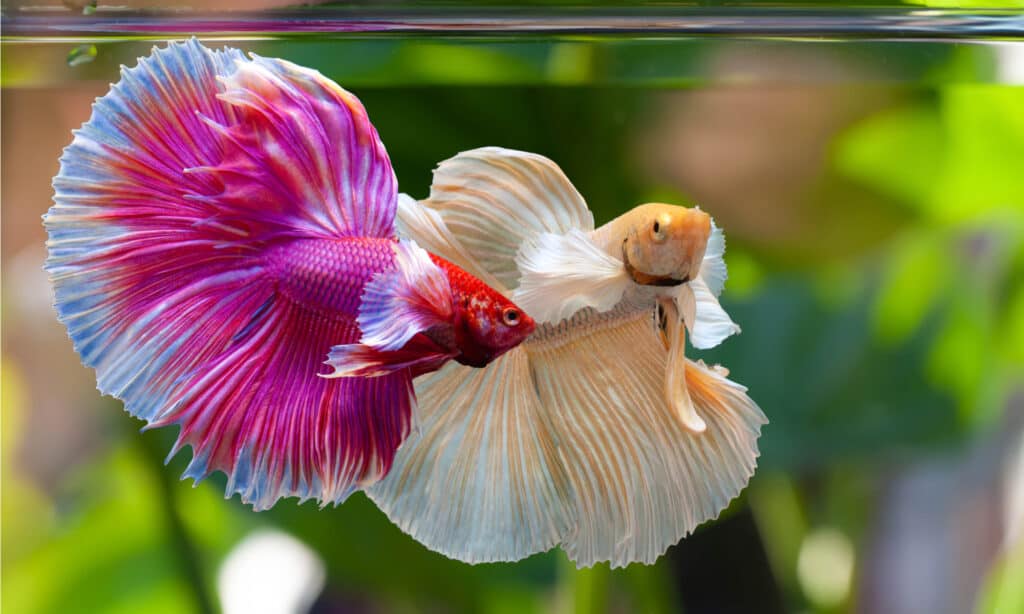Before Buying a Pet Betta Fish
Betta fish also called bettas, are colorful, low-maintenance pets perfect for people who are new to owning fish. They have different types of tails including veiltails, comb tails, halfmoons, and crown tails along with others. These are solitary fish, so it’s best to keep just one in an aquarium.
Male betta fish feature a combination of colors including bright red, brilliant blue, silver, yellow, gold and even electric green. Female betta fish have scales with a combination of colors, but they are not as striking as a male’s colors. This is why many people buy male betta fish instead of females. In addition, this color difference makes male betta fish more expensive to purchase than females. The price of these fish ranges from $10 to $25. Color, sex, and tail type all factor into the price you’ll pay for your new betta fish.
Though betta fish only grow to be a little over two inches long, this fish needs a ten-gallon aquarium. A ten-gallon aquarium costs around $20. Other supplies you need for your betta fish include a filter, heater, light, dechlorinator, gravel, rocks, plants, and fish food.

RELATED: How Big Do Betta Fish Get?
How Much Does a Betta Fish Cost?
As with any pet, there are initial costs and ongoing costs connected with a betta fish. The first initial cost is the price of the fish itself. The cost of a betta fish ranges from $10 to $25. However, some pet shops have sales that may help you find one for less than $10. A rare betta fish such as a male electric green Glo fish would be on the upper end of the price range. Alternatively, a silver and red female betta fish with a halfmoon tail would be on the lower end pricewise.
It’s best to keep a single betta fish in an aquarium. This fish is nicknamed the Siamese fighting fish for a reason. They don’t get along with other betta fish. This is especially true with two male bettas.
Your betta needs a ten-gallon aquarium or larger if you want to invest in a bigger one. A ten-gallon aquarium costs around $20.
These fish need a filter in their aquarium. A filter continually cleans the water allowing your pet to live in a healthy environment. A filter suitable for a ten-gallon aquarium costs from $10 to $20.
These are warm water fish. In fact, bettas need water with a temperature between 74 to 82 degrees Fahrenheit. So, this fish needs a heater. A 10-watt heater is appropriate for a ten-gallon tank. These are priced between $15 and $20.
Your betta’s aquarium needs a light. A light can be purchased in the form of a hood or partial hood that fits on top of a ten-gallon aquarium. You can choose fluorescent or LED lights. An LED light is the less expensive option at $20 to $40.
A magnetic algae scraper is a handy tool you can use to remove the algae from the walls of your fish’s aquarium. This tool costs around $10.
A gravel vacuum is another worthwhile purchase for cleaning your betta’s aquarium. It vacuums debris from around and beneath the gravel. Gravel vacuums are priced at around $15.
A small bottle of dechlorinator is another item on the supply list for a betta fish. One bottle lasts for several months and costs around $5.
Gravel is a common choice for covering an aquarium floor. It’s easy to clean and you have lots of color choices available to you. A supply of gravel for a ten-gallon aquarium costs $8 to $10.
Plants and rocks make your betta’s aquarium complete. You can choose live or artificial plants to put inside your betta fish’s tank. Artificial plants are less expensive and available in different types, sizes, and shapes. Plus, these fish like to hide in their habitat, so a rock cave is a favorable choice. Two or three plants cost $6 to $10 while a rock cave costs between $8 and $20.
Food for a betta fish comes in the form of tiny pellets. These supply your betta with protein, fat, and fiber. In addition, betta fish are carnivores so feeding them frozen brine shrimp gives them the extra nutrients needed to stay healthy. Frozen brine shrimp come in the form of a small cube you drop into the tank. A three-month supply of pellets costs around $3 while a two-month supply of frozen brine shrimp costs around $8.

Initial Cost of Owning a Pet Betta Fish:
- Betta fish-$10
- 10-gallon aquarium-$20
- Filter-$10
- Heater-$15
- Light-$20
- Magnetic algae scraper-$10
- Gravel vacuum-$15
- Dechlorinator-$5
- Gravel-$8
- Plants-$6
- Rock cave-$8
- Food pellets-$3
- Frozen shrimp brine-$8
Total initial cost: $113
Ongoing Cost:
- Food pellets-$3 (three-month supply)
- Frozen brine shrimp cubes-$8 (every other month)
- Dechlorinator-$5 (one year supply)
Total yearly ongoing cost: $65
Total cost of owning a betta fish over its lifetime of three years: $308
New Owner Shopping List: What to Buy
Before you bring home your betta fish, it’s a smart idea to have its aquarium setup. It can be stressful for any type of fish to be taken out of one aquarium and put into another. So, setting up its habitat ahead of time can cut down on some of that stress.
Setting up an aquarium for your betta fish includes cleaning the tank, putting in the gravel, rock cave and plants, heating the water to the proper temperature and getting the filter up and running. Of course, it gives you a chance to make sure all of your equipment works. Its supplies:
- 10-gallon aquarium – This small fish likes to move around a lot and shake its elaborate tailfin. A 10-gallon tank is a good size for this colorful fish. Don’t forget to put it on a stable surface. Here are the best betta fish tanks, reviewed and ranked!
- Filter – Though a betta fish should live alone, there’s still a lot of debris floating in its aquarium. A filter can keep the water clear and clean for your new pet.
- Heater – The water for a betta fish should be from 74 to 82 degrees Fahrenheit. A heater helps you maintain the warmth this fish needs for its watery habitat.
- Light – The light in your betta fish’s aquarium lets it know when its time to eat and rest. When the light is on during the day, it’s a signal to your fish to eat as well as get in some vigorous activity. When you click it off at night, it’s a signal to your betta to rest. On another note, an aquarium light can show off the swirling colors of your betta’s scales.
- Gravel – Part of the fun of having gravel in your betta fish’s aquarium is you get to choose from a variety of colors. Some owners combine colors for extra fun!
- Rock cave – A rock cave for a betta fish has several entrances and exits. Most importantly, it has a place where your betta can disappear and hide for a while. Be sure to look for a rock cave made with non-toxic materials.
- Plants – Two or three types of artificial plants add interest to your betta’s aquarium and give it something to swim around. Get two or three plants of different heights and types to make your fish’s habitat even more visually appealing.
- Dechlorinator – Put a drop or two of dechlorinator into your betta’s aquarium right after refreshing its water. This gets rid of chlorine that can be harmful to your pet. It’s important to wait ten minutes before putting your betta back into its aquarium.
- Pellet food – It’s hard to believe that one little pellet provides a betta fish with many of the nutrients it needs to remain healthy. A betta fish gets two pellets each day. A .95-ounce container of pellets lasts around three months.
- Frozen brine shrimp – This is an important addition to your betta’s daily intake of nutrients. The frozen brine shrimp comes in cube form. Some betta fish take up to a week to eat an entire frozen brine shrimp cube. Others eat it right away!
Ongoing Needs: What You Need to Care for Your Betta Fish
Food in the form of pellets and frozen brine shrimp is an ongoing need of your pet betta fish. Dechlorinator is another ongoing need of this fish. Of course, if any pieces of aquarium equipment including the heater, filter, or light breakdown, they’ll need to be replaced.
- Food pellets – These supply a betta fish with the nutrients it needs to maintain its energy level and the brilliant colors of its scales.
- Frozen brine shrimp – Carnivorous fish need meat in their diet! This is the meat portion of a carnivorous betta’s diet. It’s a cube of meat the fish nibbles on over a few days or a week.
- Dechlorinator – One small bottle can last for as long as a year. But it’s necessary to ensure this solution maintains its effectiveness at getting rid of chlorine.
Exercise and Ongoing Care
Unlike a pet gerbil or guinea pig, a fish doesn’t need to be taken out of its aquarium to exercise! Bettas are lively fish and have enough space in a 10-gallon aquarium to swim up and down, waving their flowing fins. Take note, when a betta fish gets going, it can really swim at a fast pace.
Cleaning the Aquarium
The filter in an aquarium is excellent at removing debris on a regular basis so a thorough cleaning is only required every three months.
Taking a betta fish out of its aquarium and putting it in a temporary bowl can cause it a lot of stress. So, leave your betta fish in its aquarium while you clean.
First, wash your hands thoroughly and dry them. Next, turn off the filter, heater, and light, then remove the rock cave and plants. Use your magnetic algae scraper to clean the walls of the aquarium. Be sure to clean all of the glass walls even if you don’t see any obvious algae. There may be invisible residue on the glass.
The next step is to remove one third of the water in your betta fish’s aquarium. Use a clean plastic cup to carefully remove the water. Then, use the gravel vacuum to remove the debris at the bottom of the tank. After you finish vacuuming, refill the rest of the tank with fresh water.
A soft bristle toothbrush can be used to clean the film off the rock cave and plants that go into your aquarium. Check out the aquarium filter to decide whether it needs to be cleaned and whether the cartridge needs to be changed.
Put the clean rock cave and plants back into the aquarium and turn on the filter, heater, and light.
Refreshing the Water
Taking out one third of the aquarium’s water is a part of its thorough cleaning routine. It should also be done every two weeks.
Refreshing the water in this way is less stressful to your pet than taking the betta out, emptying all of the water, and then refilling it. Plus, it takes a bit of time for a new tank of water to warm up to suit the needs of a betta fish.
Feeding Your Betta Fish
A betta fish needs to be fed two pellets once a day. It’s best to pour two pellets into your palm instead of trying to pour them into the aquarium from the container. This prevents you from accidently pouring too many pellets into the aquarium.
Once a week, drop a frozen shrimp brine cube into your betta’s aquarium. These cubes are nutritious and fulfill this fish’s need for meat in its diet.
Here is more helpful information on what betta fish eat.
How Long Will Your Betta Fish Live?
The lifespan of a betta fish is 2 to 3 years. Though they are known as hardy fish, they can become ill very quickly. An advantage of having just one betta fish in an aquarium means illness can’t be passed between your bettas. Here is more information on the lifespan of betta fish.
Common Health Issues for Betta Fish
A common health issue of betta fish is called ich pronounced ick. This disease takes the form of white spots on its fins. Stress and dirty water can lead to ich. Fortunately, there are treatments for ich that can be poured straight into the fish’s water.
Where to Buy Your Betta Fish
The easiest place to find betta fish is at your local pet shop. But, if you’re looking for a particular tailfin type or color, a breeder would be a better option. However, breeders charge more for their bettas than most pet shops.
Regardless of which option you choose, you’ll be provided with a container or plastic bag to transport your betta home.
Special Considerations with Betta Fish
Other Occupants of a Betta Fish Tank
Betta fish are aggressive with other bettas. That’s why it’s not a good idea to keep them in the same aquarium. But there are other things you can put into an aquarium with a betta fish.
Snails are known to do well in an aquarium with a betta fish. They help to clean up algae on the bottom of a tank and have a protective shell if your betta ever tries to stir up trouble!
Marimo moss balls are living vegetation you can add to your betta’s tank. Some bettas enjoy hiding in or nibbling on a marimo moss ball in their habitat.
Pet Betta Fish Guide: What You Need to Know FAQs (Frequently Asked Questions)
How do I go about buying a betta fish?
Research betta fish to decide what color you’d like and what type of tailfin you’d prefer for your pet. Then, visit your local pet shop to see what it has to offer.
What is a good price to buy a betta fish?
A good price for a betta fish is $10.
What is the safest way to buy a betta fish?
Look for a betta fish with flowing fins that are free of tears. A healthy betta fish is lively with colorful scales.
Are betta fish easy to care for?
Yes, they are easy to care for once you establish a routine.
Can betta fish live in tap water?
Yes, but dechlorinator must be added to remove the chlorine.
Do betta fish need a light?
Yes, they need to know when to eat and sleep.
Do betta fish get lonely?
No. These are solitary fish that do not like other bettas in their aquarium.
Can betta fish bite?
Yes, they can bite other fish and, of course, they bite into their fish food.
Thank you for reading! Have some feedback for us? Contact the AZ Animals editorial team.




